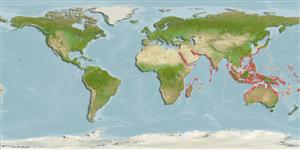Preferred temperature (Ref.
123201): 24.6 - 29.3, mean 28.4 °C (based on 3100 cells).
Phylogenetic diversity index (Ref.
82804): PD
50 = 0.5000 [Uniqueness, from 0.5 = low to 2.0 = high].
Bayesian length-weight: a=0.01023 (0.00477 - 0.02194), b=3.02 (2.84 - 3.20), in cm total length, based on LWR estimates for this (Sub)family-body shape (Ref.
93245).
Trophic level (Ref.
69278): 3.3 ±0.06 se; based on food items.
Resilience (Ref.
120179): Medium, minimum population doubling time 1.4 - 4.4 years (Preliminary K or Fecundity.).
Fishing Vulnerability (Ref.
59153): Low vulnerability (12 of 100).
Nutrients (Ref.
124155): Calcium = 74.8 [39.3, 146.8] mg/100g; Iron = 0.625 [0.318, 1.120] mg/100g; Protein = 19 [17, 21] %; Omega3 = 0.137 [0.063, 0.247] g/100g; Selenium = 17.2 [8.9, 34.0] μg/100g; VitaminA = 126 [34, 424] μg/100g; Zinc = 1.77 [1.20, 2.59] mg/100g (wet weight);
